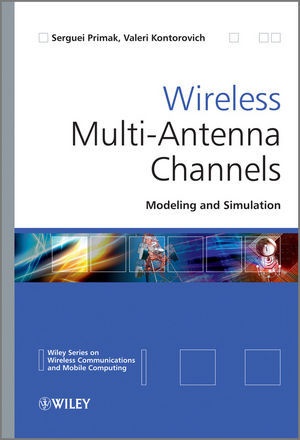Read more
Informationen zum Autor Professor Serguei L. Primak, The University of Western Ontario, Canada Professor Primak is an Associate Professor at the University of the Western Ontario, Canada. His main areas of interest include modelling and performance evaluation of MIMO systems, Markov processes, non-Gaussian random processes and communications aspects of robotic assisted telesurgery. He has co-authored a book "Stochastic Methods and their Applications to Communications: Stochastic Differential Equations Approach", Wiley, 2004. Professor Valeri Kontorovich, CINVESTAV-IPN, Mexico Professor Kontorovich is a Professor at the CINVESTAV-IPN, Mexico. His main areas of interest include modelling and performance evaluation of MIMO systems, Markov processes, non-Gaussian random processes, fractal, electromagnetic compatibility and other related topics. Professor Kontorovich has co-authored a book "Stochastic Methods and their Applications to Communications: Stochastic Differential Equations Approach", Wiley, 2004, and has co-authored 4 other books (In Russian) and a large number of publications in the field of communications. Klappentext This book offers a practical guide on how to use and apply channel models for system evaluationIn this book, the authors focus on modeling and simulation of multiple antennas channels, including multiple input multiple output (MIMO) communication channels, and the impact of such models on channel estimation and system performance. Both narrowband and wideband models are addressed. Furthermore, the book covers topics related to modeling of MIMO channel, their numerical simulation, estimation and prediction, as well as applications to receive diversity, capacity and space-time coding techniques.Key Features:* Contains significant background material, as well as novel research coverage, which make the book suitable for both graduate students and researchers* Addresses issues such as key-hole, correlated and non i.i.d. channels in the frame of the Generalized Gaussian approach* Provides a unique treatment of generalized Gaussian channels and orthogonal channel representation* Reviews different interpretations of scattering environment, including geometrical models* Focuses on the analytical techniques which give a good insight into the design of systems on higher levels* Describes a number of numerical simulators demonstrating the practical use of this material.* Includes an accompanying website containing additional materials and practical examples for self-studyThis book will be of interest to researchers, engineers, lecturers, and graduate students. Zusammenfassung Wireless Multi-Antenna Channels: Modeling and Simulation focuses on modeling and simulation of multiple antennas channels, including multiple input multiple output (MIMO) communication channels and impact of such models on channel estimation and system performance. Both narrowband and wideband models are discussed. Inhaltsverzeichnis About the Series Editors xi 1 Introduction 1 1.1 General remarks 1 1.2 Signals, interference, and types of parallel channels 3 2 Four-parametric model of a SISO channel 7 2.1 Multipath propagation 7 2.2 Random walk approach to modeling of scattering field 13 2.2.1 Random walk in two dimensions as a model for scattering field 13 2.2.2 Phase distribution and scattering strength 14 2.2.3 Distribution of intensity 14 2.2.4 Distribution of the random phase 17 2.3 Gaussian case 18 2.3.1 Four-parametric distribution family 18 2.3.2 Distribution of the magnitude 20 2.3.3 Distribution of the phase 27 2.3.4 Moment generating function, moments and cumulants of four-parametric distribution 29 2.3.5 Some aspects of multiple scattering propagation 29 3 Models of MIMO channels 33 3.1 General clas...
List of contents
About the Series Editors xi
1 Introduction 1
1.1 General remarks 1
1.2 Signals, interference, and types of parallel channels 3
2 Four-parametric model of a SISO channel 7
2.1 Multipath propagation 7
2.2 Random walk approach to modeling of scattering field 13
2.2.1 Random walk in two dimensions as a model for scattering field 13
2.2.2 Phase distribution and scattering strength 14
2.2.3 Distribution of intensity 14
2.2.4 Distribution of the random phase 17
2.3 Gaussian case 18
2.3.1 Four-parametric distribution family 18
2.3.2 Distribution of the magnitude 20
2.3.3 Distribution of the phase 27
2.3.4 Moment generating function, moments and cumulants of four-parametric distribution 29
2.3.5 Some aspects of multiple scattering propagation 29
3 Models of MIMO channels 33
3.1 General classification of MIMO channel models 33
3.2 Physical models 33
3.2.1 Deterministic models 34
3.2.2 Geometry-based stochastic models 35
3.3 Analytical models 36
3.3.1 Channel matrix model 37
3.4 Geometrical phenomenological models 47
3.4.1 Scattering from rough surfaces 48
3.5 On the role of trigonometric polynomials in analysis and simulation of MIMO channels 49
3.5.1 Measures of dependency 50
3.5.2 Non-negative trigonometric polynomials and their use in estimation of AoD and AoA distribution 51
3.5.3 Approximation of marginal PDF using non-negative polynomials 51
3.6 Canonical expansions of bivariate distributions and the structure MIMO channel covariance matrix 52
3.6.1 Canonical variables and expansion 52
3.6.2 General structure of the full covariance matrix 54
3.6.3 Relationship to other models 54
3.7 Bivariate von Mises distribution with correlated transmit and receive sides 56
3.7.1 Single cluster scenario 56
3.7.2 Multiple clusters scenario 58
3.8 Bivariate uniform distributions 58
3.8.1 Harmonic coupling 58
3.8.2 Markov-type bivariate density 61
3.9 Analytical expression for the diversity measure of an antenna array 62
3.9.1 Relation of the shape of the spatial covariance function to trigonometric moments 62
3.9.2 Approximation of the diversity measure for a large number of antennas 64
3.9.3 Examples 66
3.9.4 Leading term analysis of degrees of freedom 70
3.10 Effect of AoA/AoD dependency on the SDoF 72
3.11 Space-time covariance function 72
3.11.1 Basic equation 72
3.11.2 Approximations 73
3.12 Examples: synthetic data and uniform linear array 75
3.13 Approximation of a matrix by a Toeplitz matrix 77
3.14 Asymptotic expansions of diversity measure 78
3.15 Distributed scattering model 79
4 Modeling of wideband multiple channels 81
4.1 Standard models of channels 82
4.1.1 COST 259/273 82
4.1.2 3GPP SCM 83
4.1.3 WINNER channel models 84
4.2 MDPSS based wideband channel simulator 84
4.2.1 Geometry of the problem 84
4.2.2 Statistical description 85
4.2.3 Multi-cluster environment 87
4.2.4 Simulation of dynamically changing environment 88
4.3 Measurement based simulator 89
4.4 Examples 91
4.4.1 Two cluster model 92
4.4.2 Environment specified by joint AoA/AoD/ToA distribution 93
4.4.3 Measurement based simulator 95
4.5 Appendix A: simulation parameters 96
5 Capacity of c

